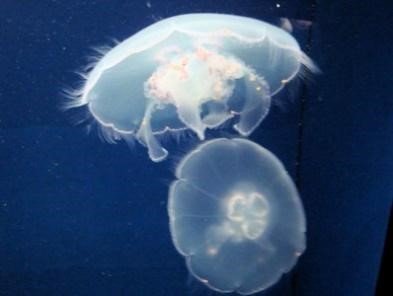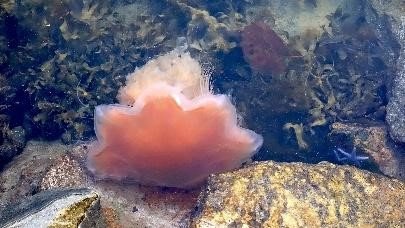Don’t Squish the JellyFish!
One of the strangest creatures that frequent our shores is the jellyfish. Jellyfish, and similar gelatinous creatures, come in a wide variety of forms. Most “true” jellyfish have translucent, bell-shaped bodies as adults, and tentacles with stingers. In general, they lack brains, blood, hearts and bones, and are made up of about 95 percent water. They are the simplest swimming animals in our oceans and have survived on Earth for over 500 million years. Jellyfish can be found all around the world—some even live in arctic waters—but most live along coastlines. All the jellyfish shown here can be found on Cape Cod.
Jellyfish swim in one of two ways. Small jellyfish (many too small to be noticed by humans) expand their bells to collect water, then contract their bells to expel it. Larger jellyfish contract just the rims of their bells in a gentle, rowing motion. While jellyfish swim, they can generally can only move up and down in a water column and can’t make horizontal progress against a current.
Jellyfish can come together in large groups called swarms. When those swarms go from large to enormous, scientists suspect that the ecosystem has been tipped off balance by environmental stress. Increases in water temperature can mean that jellies grow and reproduce at higher rates. Jellyfish can be introduced into non-native habitats by ships, and then out-compete native species for food. Jellyfish can also thrive in heavily polluted areas know as Dead Zones, where they face few predators or competitors. When jellyfish swarm in abnormally high numbers, they can block the cooling systems of power plants, clog fishing nets, and wipe out fish farms.
The sting of the Moon Jelly is mild compared to other species. "DSC24226, Moon Jelly ('Aurelia Aurita'), Monterey Bay Aquarium, Monterey, California, USA" by jimg944 is licensed under CC BY 2.0
A Mauve Stinger jellyfish. "File:Pelagia noctiluca (Sardinia).jpg" by Hans Hillewaert, licensed under CC BY-SA 4.0.
An example of abnormal swarming is seen in the comb jelly (also known as the sea gooseberry for its ovoid shape). While not a true jellyfish, but a closely related species, comb jelly populations in Narragansett Bay have doubled in recent decades. During their annual peaks, comb jellies become the dominant force in the Narragansett’s ecology.
Most jellyfish and closely related species aren’t harmful to people, but all true jelly fish and some other gelatinous creatures sting. A single tentacle may have thousands of stingers. A sting can be mildly or extremely painful, depending on the species. The box jellyfish, which inhabits tropical waters, is the world’s most venomous animal, and is capable of killing a human in under three minutes. Thankfully, human encounters are rare; in Australia, about one person per year is killed by a box jellyfish.
If you find a jellyfish on the beach, it’s wise not to touch it—even the tentacles of dead jellyfish can sting.
Article by Mary Everett-Patriquin, CCMM Public Programs Coordinator, July 2022



